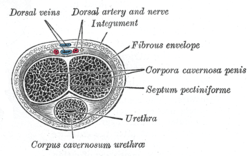Erectile tissue
Erectile tissue is tissue in the body with numerous vascular spaces that may become engorged with blood.[1][2] However, tissue that is devoid of or otherwise lacking erectile tissue (such as the labia minora, the vestibule/vagina and the urethra) may also be described as engorging with blood, often with regard to sexual arousal.[2]
Erectile tissue in the clitoris and penis

Erectile tissue exists in places such as the corpora cavernosa of the penis, and in the clitoris or in the bulbs of vestibule.[2] During erection, the corpora cavernosa will become engorged with arterial blood, a process called tumescence.[3] This may result from any of various physiological stimuli, also known as sexual arousal. The corpus spongiosum is a single tubular structure located just below the corpora cavernosa. This may also become slightly engorged with blood, but less so than the corpora cavernosa.
Other erectile tissue
Erectile tissue is also found in the nose (turbinates), ear, urethral sponge and perineal sponge.[2] The erection of nipples is not due to erectile tissue, but rather due to the contraction of smooth muscle under the control of the autonomic nervous system.
References
- ↑ "Erectile tissue". medical-dictionary.thefreedictionary.com. Retrieved June 28, 2012.
- 1 2 3 4 Yang, Claire; J. Cold, Christopher; et al. (April 2006). "Sexually responsive vascular tissue of the vulva". BJUI. 97 (4): 766–772. doi:10.1111/j.1464-410X.2005.05961.x. PMID 16536770.
- ↑ Chapter 35 in: Walter F., PhD. Boron (2003). Medical Physiology: A Cellular And Molecular Approach. Elsevier/Saunders. p. 1300. ISBN 1-4160-2328-3.
